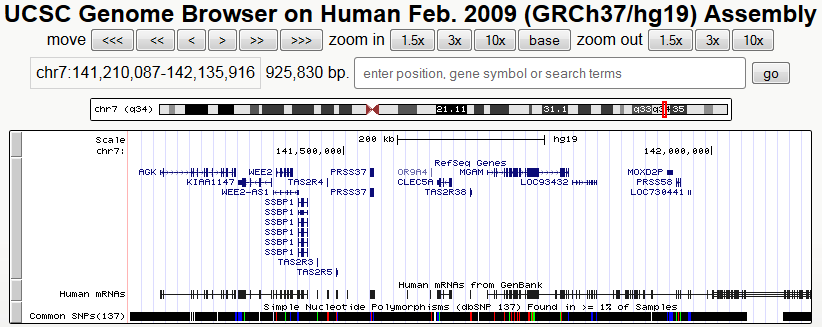This is another topic related to the undergraduate genetics teaching lab I am running this fall. There is a lot of variation among people in bitter taste perception, and one form of this is strongly affected by alternative alleles at a single gene. It is safe and easy to test both the genotype and phenotype, provides students with a first hand experience genotype-phenotype connection, and is "safe" in terms of potential medical stigma--there are no directly relevant medical issues associated with differences in bitter taste perception among the students, unlike some other traits we could test. We can also use the genotype data in other class projects such as calculating F-statistics for the class as a whole.
Humans have five types of taste perception; sweet, bitter, sour, salty and umami ("savory" discovered in Japan in 1908). Three of these are produced by ligands (ligands are molecules that bind to proteins) binding to taste receptor proteins that span cell membranes in the tongue, mouth and throat. This causes a conformation change in the receptor gene that is a component of a signal transduction cascade that finally results in opening of ion channels and a nerve impulse (action potential) travels to the brain to be interpreted and perceived as a flavor.
Type 2 taste receptors govern the detection of bitter taste (Type 1 govern sweet and umami perception). There are 43 Type 2 receptors in humans encoded by "TAS2R" genes. One of these, TAS2R38, is very well characterized and is polymorphic in human populations with both tasting and non-tasting alleles. In the image below from the UCSC genome browser you can see a schematic representation of the 7th chromosome at the top with the area of detail outlined in the red box out on the "q" (long) arm. Under this is a plot of genes in the magnified area with TAS2R38 in the middle (listed just under CLEC5A).
It is not far from a small cluster of other bitter taste receptors to the left (TAS2R3, 4 and 5) between SSBP1 and PRSS37.
The ancestral functional allele of this gene can detect some synthetic compounds, such as PROP (6-n-propylthiouracil) and PTC (phenylthiocarbamide), as well as bitter compounds in some plants like cabbage, broccoli and brussels sprout.
=[1]S)---)}$$](http://hawaiireedlab.com/wpress/wp-content/ql-cache/quicklatex.com-93ea8d67311a781ed7405c9e40934be4_l3.png)
![Rendered by QuickLaTeX.com 6-n-propylthiouracil $$\chemfig{-[:30]-[:-30]-[:30]*6(-[,,1]N(-H)-(=S)-N(-H)-(=O)-=)}$$](http://hawaiireedlab.com/wpress/wp-content/ql-cache/quicklatex.com-b2efae067f6e8e09b0c6c1c14c5ddb55_l3.png)
I like cabbage, broccoli (I like to snack on tasty raw broccoli) and yes, brussels sprouts, on the other hand my wife strongly dislikes brussels sprout and is not fond of uncooked broccoli. PCT can be used to test for TAS2R38 activity because tiny amounts of it can be soaked into paper strips and it causes a strongly bitter sensation in people, like my wife, that can taste it--she immediately rinsed her mouth out with water after tasting it. On the other hand, when I taste PTC there is only a faint "chemical" taste; it is definitely not strongly bitter or unpleasant.
Below is my sequence from PCR amplifying a section of the TAS2R38 gene.
Part of one of the primers used is indicated by the light green bar on the right. The amino acid translation of each set of three nucleotides is indicated by single letters just under the top DNA sequence. At position 239-241 I have a valine (V) (underlined with the yellow arrow box above) whereas many people have an alanine (A). This is because the second nucleotide in the codon (with the small yellow box below it) changed from a C to T, changing the codon from GCT (coding for alanine) to GTT (coding for valine). The trace file is "clean," there does not appear to be both a C and T peak at the same position, indicating I, like 30% of the other people in the world, am homozygous and have two copies of the altered allele. The valine form of the protein does not change conformation when these types of bitter compounds are present. However, the phenotype associated with this allele is recessive. Having at least one functional copy (like the 70% of the rest of you) means you can detect PCT and related molecules. This may explain the difference in food preference between my wife and I.
There is also anecdotal evidence of an inverse effect with other compounds: Henkin and Gillis 1977 "Divergent taste responsiveness to fruit of the tree Antidesma bunius" Nature 265: 536-537. The fruit of the bignay tree seems to be sweet to people with TAS2R38 "taster" alleles and bitter to people who cannot taste PTC. The bignay is used as food in Southeast Asia and Northern Australia. Interestingly, the frequency of PTC tasters is not uniform around the world but ranges from a high of over 90% among Native Americans to less than 60% among Native Australians and New Guinea--where the bignay grows.

